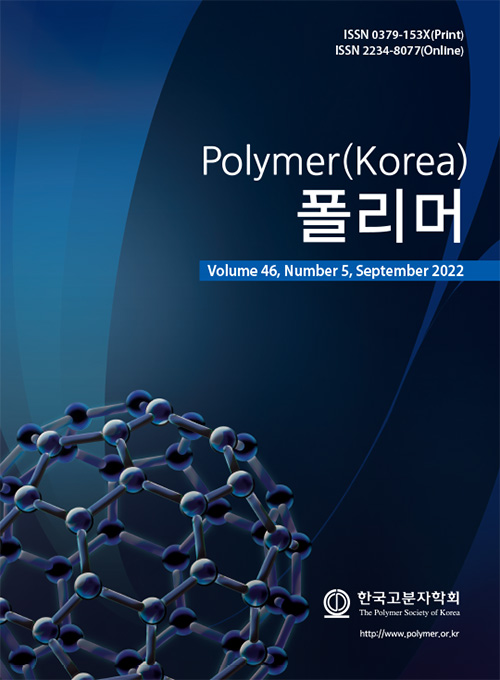- Non-isothermal Crystallization of Poly(3-hydroxybutyrate-co-4-hydroxybutyrate)
Soomi Kwon, Tao Zhang, Yunjae Jang*, Minho Jung*, Eunhye Lee*, and Ho-Jong Kang†

Department of Polymer Science and Engineering, Dankook University, 152 Jukjeon-ro, Suji-gu, Yongin-si, Gyeonggi-do 16890, Korea
*CJ Cheiljedang Corp. 55, Gwanggyo-ro 42beon-gil, Yeongtong-gu, Suwon-si, Gyeonggi-do 16495, Korea- Poly(3-hydroxybutyrate-co-4-hydroxybutyrate) 비등온 결정화 거동
단국대학교 고분자공학과, *CJ 제일제당
Reproduction, stored in a retrieval system, or transmitted in any form of any part of this publication is permitted only by written permission from the Polymer Society of Korea.
The non-isothermal crystallization behavior of poly(3-hydroxybutyrate-co-4-hydroxybutyrate)(P(3HB-co-4HB)) was studied. It was found that the non-isothermal crystallization behavior of P(3HB-co-4HB) was affected even with a small change in the melt processing temperature of 10-20 oC. It can be understood as the effect of low molecular weight (3HB-co-4HB) formed by the thermal degradation because of inherent low thermal stability of biodegradable P(3HB-co-4HB) in melt processing. The crystallization temperature and enthalpy decreased with increasing melt processing temperature. In addition, it can be seen that the perfectness of crystal formed in the non-isothermal crystallization of random copolymer also varies depending on the processing temperature. P(3HB-co-4HB) crystals formed under the rapid solidification were made in the 3HB rich phase regardless of the melt processing temperature. Crystals formed under the slow solidification were made both in the 3HB and 4HB rich phases and increasing melt processing temperature makes it difficult to form crystals in the 4HB rich phase. Modified Avrami equation and Avrami-Ozawa equation were fitted well for the non-isothermal crystallization of P(3HB-co-4HB). It was confirmed that the cooling rate and melt processing temperature affect the crystallization rate and the shape of the crystal of P(3HB-co-4HB).
Poly(3-hydroxybutyrate-co-4-hydroxybutyrate)(P(3HB-co-4HB))의 용융 가공온도에 따른 비등온 결정화 거동 변화를 살펴보았다. 10-20 oC의 작은 용융 가공온도 변화에도 P(3HB-co-4HB)의 비등온 결정화 거동이 달라짐을 확인하였다. 이는 용융 가공에서 생분해성 P(3HB-co-4HB)의 원천적으로 낮은 열안정성에 따른 열분해에 의하여 발현된 저분자 P(3HB-co-4HB)의 영향으로 해석할 수 있다. 용융 가공온도 증가에 의한 열분해로 인하여 결정화 온도와 엔탈피 감소를 확인할 수 있었다. 이와 함께 비등온 결정화에서 형성된 공중합체 결정의 완전성도 용융 가공온도에 따라 달라짐을 알 수 있다. 급랭 고상화 조건에서 형성된 P(3HB-co-4HB) 결정은 용융 가공온도와 관계없이 랜덤 공중합체의 3HB rich phase에서 주로 형성되는 반면, 서냉 고상화 조건에서는 3HB rich phase와 4HB rich phase에서 동시에 결정이 형성되며 용융 가공온도가 증가될수록 4HB rich phase에서 결정화가 어려움을 확인하였다. Modified Avrami 식과 Avrami-Ozawa 식은 P(3HB-co-4HB)의 비등온 결정화 거동 해석에 잘 맞으며 냉각속도와 용융 가공온도는 P(3HB-co-4HB)의 결정화 속도와 결정 형태에 영향을 미침을 알 수 있었다.
Keywords: poly(3-hydroxybutyrate-co-4-hydroxybutyrate), thermal degradation, non-isothermal crystallization, perfectness of crystal.
- Polymer(Korea) 폴리머
- Frequency : Bimonthly(odd)
ISSN 0379-153X(Print)
ISSN 2234-8077(Online)
Abbr. Polym. Korea - 2022 Impact Factor : 0.4
- Indexed in SCIE
 This Article
This Article
-
2022; 46(5): 661-670
Published online Sep 25, 2022
- 10.7317/pk.2022.46.5.661
- Received on May 28, 2022
- Revised on Jun 29, 2022
- Accepted on Jun 30, 2022
 Correspondence to
Correspondence to
- Ho-Jong Kang
-
Department of Polymer Science and Engineering, Dankook University, 152 Jukjeon-ro, Suji-gu, Yongin-si, Gyeonggi-do 16890, Korea
- E-mail: hjkang@dankook.ac.kr









 Copyright(c) The Polymer Society of Korea. All right reserved.
Copyright(c) The Polymer Society of Korea. All right reserved.